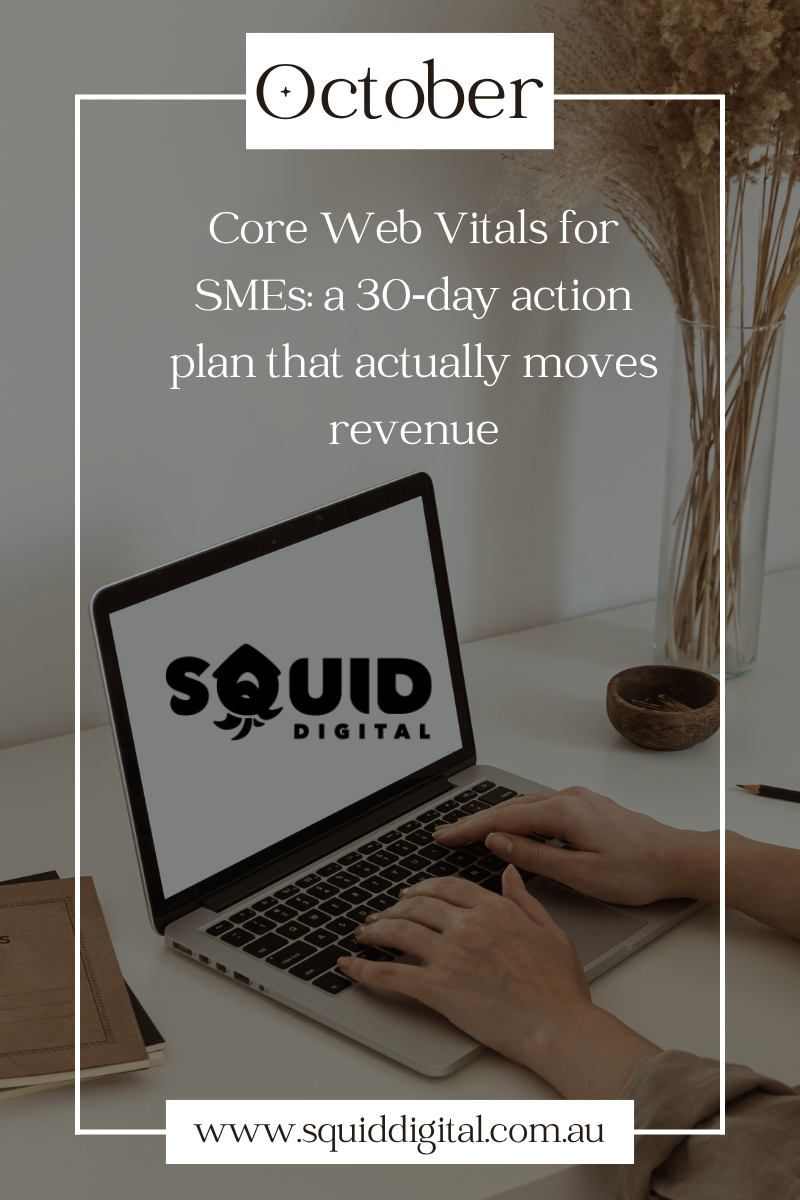
Core Web Vitals for SMEs: a 30‑day action plan that actually moves revenue
When founders ask why their paid media isn’t converting, we often find the real culprit sitting under the hood: a slow, jittery site. Core Web Vitals (CWV) are Google’s way of measuring the experience people actually feel—how fast the first big piece of content appears (LCP), how stable the page is as it loads (CLS), and how quickly the page responds to input (INP). You don’t need a rebuild to fix these. You need discipline, a speed budget and a 30‑day sprint.
What good looks like (in plain English)
-
LCP ≤ 2.5s: The main content paints quickly—think hero image or headline.
-
CLS ≤ 0.1: The layout doesn’t jump around while loading.
-
INP ≤ 200ms: Clicks, taps and typing feel snappy.
-
TTFB ≤ 0.8s in Australia: The server responds fast for local users.
Week 1: Baseline and quick wins
-
Measure reality, not hope. Use PageSpeed Insights and real‑user data (CrUX if available). Capture desktop/mobile separately.
-
Turn on a strict speed budget. Set hard budgets for page weight (≤ 1.5 MB), requests (≤ 60) and third‑party scripts (≤ 8).
-
Image overhaul. Convert hero assets to AVIF/WebP, set correct dimensions, and serve responsive srcset. Kill carousels; a single sharp image beats five soft ones.
-
Fonts and CSS. Use font-display: swap, preconnect to font hosts, and inline critical CSS for the first viewport.
Week 2: JavaScript hygiene and render order
-
Defer the non‑critical. Tag manager bloat, chat widgets, A/B tools—defer or load on interaction.
-
Ship less JS. Remove dead libraries, replace heavy sliders with CSS, and use native browser features over frameworks where possible.
-
Stabilise the layout (CLS). Reserve space for images, ads and embeds using width/height attributes or CSS aspect‑ratio boxes.
-
Preload the hero. Preload the main image and any critical web font.
Week 3: Edge, caching and hosting configuration
-
CDN rules that actually cache. Cache HTML for anonymous users, set sensible TTLs, and avoid accidental cache bypasses.
-
Geography matters. Ensure edge POPs close to Sydney/Melbourne/Brisbane. If your TTFB from Sydney exceeds ~800ms, investigate hosting.
-
Compress everything. Brotli for text, modern formats for images, HTTP/2 or HTTP/3 for multiplexing.
-
Server work. Keep PHP/Node runtimes and CMS cores updated; enable opcache; use object caching where supported (Redis/Memcached).
Week 4: Governance and monitoring
-
Speed guardrails in CI. Block merges that exceed budgets.
-
Weekly checks. Track LCP/INP/CLS in Search Console and with an RUM tool.
-
Content discipline. Train editors on image sizes and embeds so performance doesn’t regress.
-
Celebrate the revenue link. Compare conversion rate and CPA before/after; speed improvements compound CRO and SEO.
Common mistakes to avoid
-
Chasing a 100/100 score instead of a fast, stable real‑world experience.
-
Installing “performance” plugins that add more JS than they remove.
-
Ignoring mobile; your buyers will not wait on 4G.
-
Treating CDN as a switch—configuration is where the gains are.
Want help running a 30‑day CWV sprint? Book a site review—no redesign required.






